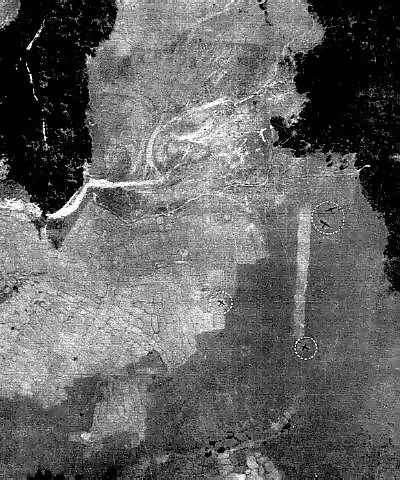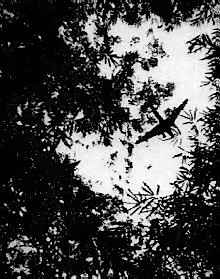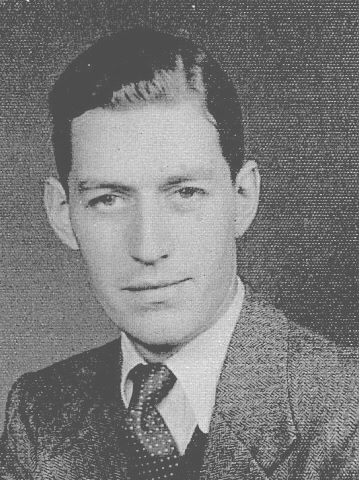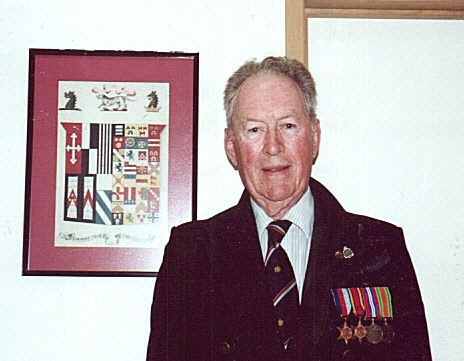|
|
|
BROADWAY
and Peter Homfray

"Broadway" Air Strip carved out of the jungles of Burma
enemy lines by airborne invasion = "Operation Thursday."
Note crashed gliders circled with dotted line
Brigadier General W. D. Old, who had flown in from his headquarters at Comilla, met us on the ramp. Sylhet had been an RAF installation while under construction. General Old declared it operational the next day, 13 January. I was assigned base commander a task which would be additional to my job as squadron commander.
He issued operational orders to commence air dropping supplies to British ground troops fighting in the Tiddim area. We had less than 24 hours to find a place to sleep, something to eat and work out plans and the loading of supplies. Only transports available were the bicycles we brought with us and a few British lorries.
Our new base was over-run by thousands of Indian laborers, monkeys and jackals.
A few days after we arrived a young British captain, named Peter Homfray, brought me a note from Major General Orde Wingate, commander of the Third Indian Division, requesting indefinite use of an isolated building on the base with 24 hour security guard. Captain Homfray’s mission was classified “Most Secret.” The requested arrangements were made and Homfray moved in. We saw him occasionally at the mess tent, but had no idea what he was up to.
As the weather got warmer our little outpost at Sylhet became a beehive of activity. General Wingate moved his headquarters from Imphal to our base and General Merrill, with his “Marauders,” began their march from the north down central Burma. Brigadier Bernard Fergusson led the British column south down the Chindwin River. Our air drops were diverted from the Tiddim area to supply these columns.
Many distinguished visitors began to arrive in Sylhet, both British and American. Finally Lord Mountbatten showed up with Hurricane Fighter escort. General Wingate then called us all together and laid out his plans for the airborne invasion of Burma to be known as “Operations Thursday,” a daring attempt to interdict the Japanese supply lines in central Burma and cut off the enemy to the north.
In the summer of 1943 Wingate had led a long-range penetration, column overland, behind Japanese lines which had been moderately successful in harassing the enemy and slowing up his advance through Burma. During this trek he had discovered several large savannahs along the Irrawaddy River. He reasoned that with proper air support and air supplies he could establish “strongholds” at these areas from which his long-range columns could operate with all supplies, evacuation of wounded, and rotation of personnel being accomplished by air.
He took his dreams to the Quebec conference where Roosevelt and Churchill approved.
The tactical and logistical problems
implicit in this operation were formidable. Gliders had to be towed in
under cover of darkness, since Japanese fighter air fields were located
throughout central Burma. The first several gliders to each target
would carry heavily-armed infantrymen to counter any enemy resistance.
The next several sorties would carry small earth-moving machines to carve
out landing strips. Successive waves would bring in men, mules and initial
stores of supplies, weapons, and ammunition.
On Sunday, 5 March 1944, we were in our cockpits ready for take-off. Some 200 pairs of gleaming white nylon tow ropes were strung out on the grass field at Lallaghat, India behind the nearly 100 C-47 airplanes. Each tow planes was to pull two gliders. These gliders were loaded to a gross weight of 16,000 pounds each. No one really knew whether they would fly, much less clear the 8,000-foot Chin Hills to the east. Douglas designers had limited the weight of the C-47 to 26,900 pounds. This was a total of nearly 50,000 pounds. A last minute photo reconnaissance by one of Colonel Phil Cochran’s P-51s showed that one of the targets – “Piccadilly” – had apparently been barricaded by huge teak logs dragged in by elephants. (see note # 1) Thoughts came to mind that the Japanese discovered our plan and were going to force all traffic into “Broadway” some 50 miles to the north, where they would be waiting for us. The decision was made – all flights go into “Broadway.”
At full take-off power the engines roared and the ship shuddered a moment and the wheels slid in the grass. Finally it moved and we gathered enough speed to stagger off just before the jungle met us. We had to make six orbits over the field to gain enough altitude to clear the mountain.
We lived a hundred years and died a thousand deaths on that 250 mile flight in the darkness to an unknown, and perhaps an unrecognizable destination. Fuel gauges were winding down at an alarming rate and the engines were heating badly due to the excess power and lack of cooling slip stream. Patches of turbulence caused the gliders to wallow badly. Controlling the aircraft was quite a problem.
We spotted a clearing in the moonlight which we hoped was “Broadway.” There were no lights nor radio communications. We had burned two-thirds of our fuel going one half the distance. The inter-phone from one of our gliders crackled. It was Colonel John Allison, flying one of the gliders. He was to assume command of all operations at “Broadway.” “Alison overboard, this looks as good as any.”
We returned to Lallaghat with but 40 gallons of fuel in the tanks and 30 gallons of sweat in the cockpit. Being the first ship back, the moment we cleared the runway we cut the engines. General Old jumped on board for a report. We told him that the double tow was murder and that we were going to lose a lot of gliders and men. From that point on all was single tow. Sadly a lot of men went down with their gliders in the jungle.
No enemy action was encountered until several days later at which time we had air-landed thousands of troops, weapons and supplied. The first landing at “Broadway” by a C-47 was made in less than 24 hours after the first glider had landed.
Other target areas were opened in the same way — “White City,” “Aberdeen” and “Chowringhee.” We supplied in addition to evacuating wounded and prisoners every night until the monsoon hit full force in mid May. Supplementing our air landings were many air drops to the heads of the far-ranging columns east and south of the “strong-holds.”
And now back to Peter Homfray.
About 1 March Peter showed up at headquarters with Major General Ramsey, deputy to General Wingate. They led me to Peter’s secret hide-away. It was filled to the rafters with little dummy British soldiers in full battle dress. Each had his own parachute and was stuffed to the gills with delayed fuse explosives. They were to be dropped at half light in the jungle clearings the morning of the airborne invasion some 50 miles north of the real targets, as a diversion. In poor light the illusion is that these are full-sized paratroopers just a little further away. Once on the ground the little fellows were programs to “pop off” for about 14 hours.
The native jungle grapevine went into action the trick worked perfectly. This mock battle drew most of the Japanese forces in that area of Burma into the fake invasion spot. “This accounted for the lack of opposition on the initial sorties into “Broadway.”
Peter had been the major domo for a
similar operation earlier, in the invasion and recapture of Madagascar.
Peter was a charming young Englishman. In war there is a role for everyone
— even the illusionist.
In late March Peter came to headquarters requesting that I take him to “Broadway.” It was his turn to rotate as one of the leaders of the long-range penetration columns. His tour would end on 23 April and we were to pick him up returning him to Sylhet. By then “Broadway” had become a hot spot with nightly attacks by the Japanese on the air strip. We arrived on schedule on 23 April and waited quite awhile. A fire fight was raging between the enemy and the Gurkhas. There was no sign of Peter. All of our inquiries at “Broadway” and subsequent ones at headquarters came to naught except that “Captain Homfray was missing in action.
We never saw Homfray again. After the war Major Burwell wrote a letter of condolence to his widow in care of the British War Office in London. Some time later a cable from New Delhi, India was received “All’s well with me, letter follows, regards, Homfray. What a delightful surprise.
His letter explained, in detail, how he had been wounded, rescued and air-lifted back to a hospital in India where he spent several months recuperating. Last we heard he was emigrating to Tasmania.
 To
the Chindit, as he looks to the heavens, the most beatiful lady in flight
To
the Chindit, as he looks to the heavens, the most beatiful lady in flightThe foregoing article is condensed from a tale written
by BURWELL, Lewis C., Jr. former commander of the Twenty-Seventh Troop
Carrier Squadron.
With in a few weeks after placing our tale “Broadway and Peter Homfray” on our web site we were elated to find a sign in from Peter, now living in Australia. Here following is a photo taken during the war years and one of later vintage along with a copy of his “Chindit” shoulder patch.


Harry A. Blair
Historian
Twenty-Seventh Troop Carrier Squadron
La Crosse, Wisconsin
4 November 1989